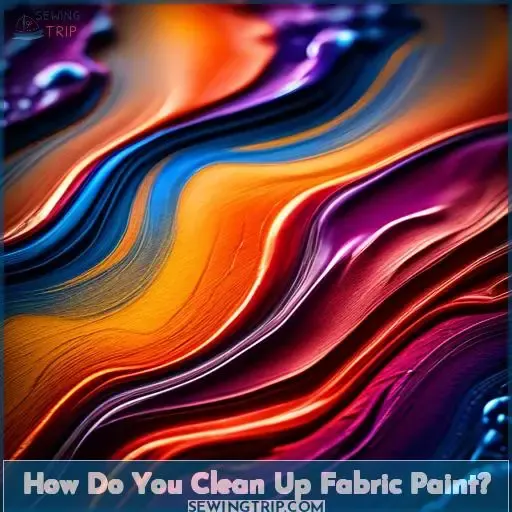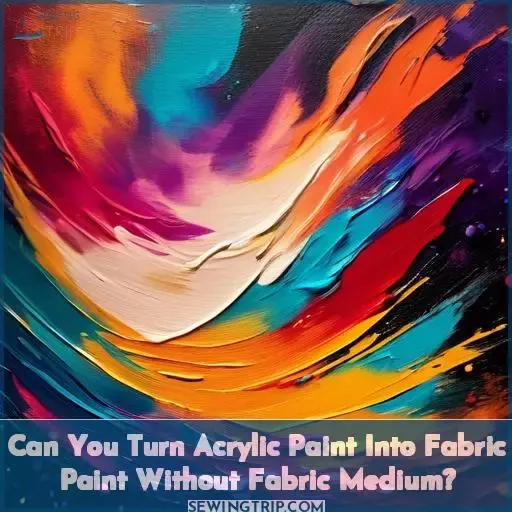This site is supported by our readers. We may earn a commission, at no cost to you, if you purchase through links.
 Unleash the power of acrylic paint on fabric with these expert tips and tricks!
Unleash the power of acrylic paint on fabric with these expert tips and tricks!
Discover how to make acrylic paint stay put on fabric, ensuring vibrant colors that last.
Learn the secrets of using textile medium to transform your acrylic paint into fabric paint that’s washable and permanent.
Dive into the world of fabric painting with confidence and creativity, ready to elevate your DIY projects to a whole new level.
Table Of Contents
- Key Takeaways
- How to Make Acrylic Paint Stay on Fabric
- What is Fabric Paint?
- Why Should I Turn Acrylic Paint Into Fabric Paint?
- What is Textile Medium?
- How to Mix Acrylic Paint and Textile Medium
- How Do You Set Fabric Paint?
- How Do You Clean Up Fabric Paint?
- Can You Turn Acrylic Paint Into Fabric Paint Without Fabric Medium?
- How Else Can You Turn Acrylic Paint Into Fabric Paint?
- Frequently Asked Questions (FAQs)
- Conclusion
Key Takeaways
To make acrylic paint stay on fabric, add a fabric medium to the paint. This medium helps the paint stay flexible and fade-resistant.
Mix 1 part fabric medium with 2 parts acrylic paint. The fabric medium is a liquid that mixes easily with the paint and doesn’t alter its color.
After the paint is completely dry, heat set it for permanency and washability. Heat set the fabric using an iron on medium or high heat for 3-5 minutes, or put the garment in the dryer for about an hour.
Follow the fabric medium manufacturer’s instructions for heat setting.
How to Make Acrylic Paint Stay on Fabric
To make acrylic paint stay on fabric, you can follow these steps:
- Prepare the fabric: Wash and dry the fabric before painting, as this will help the paint adhere better to the fabric.
- Use a fabric medium: Mix the acrylic paint with a fabric medium to improve its adhesion to the fabric. This can be done by following the instructions on the fabric medium’s packaging.
- Heat seal the paint: After the paint has dried, heat the fabric using an iron on the highest setting, making sure there is no water in the iron and it is set to NO STEAM. Press the iron onto the painted area for 30 seconds, then lift and move to a new section until the entire area is pressed.
- Optional: For added protection, you can apply a fabric sealant or spray, such as GAC 900, over the painted fabric once it is completely dry.
By following these steps, you can ensure that the acrylic paint stays on the fabric and is less likely to wash away.
What is Fabric Paint?
[FIRST SUBTOPIC]:
What is Fabric Paint?
Fabric paint is a type of paint specifically designed for use on fabric, allowing it to adhere and remain durable after washing. It’s not just a simple transformation of acrylic paint into fabric paint; it’s a whole new realm of creativity that opens up a world of possibilities.
With fabric paint, you can navigate the complexities of fabric choices, color mixing, brush selection, drying times, and design inspiration. It’s designed to enhance your fabric painting project, not just make it possible.
Fabric paint isn’t merely a bespoke or tailored solution; it’s a tool that empowers you to unlock the secrets of fabric painting and unveil the secrets of your own creativity. It’s not just about turning acrylic paint into fabric paint with a textile or fabric medium; it’s about seeking more than just a paint that stays on fabric.
It’s about finding a paint that’s robust and reliable, ready to withstand the ever-evolving world of fabric painting.
So, when it comes to fabric paint, remember that it’s not just about the paint itself; it’s about the journey you take towards creating something unique and beautiful. It’s about the joy of navigating the everchanging realm of fabric painting and finding joy in the heart of the process.
Whether you’re a seasoned artist or just starting out, fabric paint is the perfect tool to help you bring your vision to life.
Why Should I Turn Acrylic Paint Into Fabric Paint?
Why should you turn acrylic paint into fabric paint? There are several reasons why turning acrylic paint into fabric paint is beneficial. Firstly, it allows for greater versatility in the types of fabric you can paint on.
Acrylic paint isn’t always suitable for all fabric types, but by adding a fabric medium, you can ensure that the paint adheres effectively to a wider range of fabrics.
Secondly, turning acrylic paint into fabric paint makes the paint more flexible and fade-resistant. This is crucial for creating durable and long-lasting designs on fabric items, as the paint won’t crack or peel over time.
Thirdly, using fabric medium in your acrylic paint can enhance the creativity of your work. The medium can change the texture and appearance of the paint, allowing you to experiment with different effects and finishes.
Lastly, turning acrylic paint into fabric paint can be more affordable and offer more color options. You may already have acrylic paint on hand, and by adding a fabric medium, you can create your own fabric paint without having to purchase specialized fabric paint.
In summary, turning acrylic paint into fabric paint offers versatility, durability, creativity, affordability, and the ability to experiment with different effects and finishes on fabric items.
What is Textile Medium?
Textile medium is a liquid that’s added to acrylic paint to transform it into fabric paint. It’s a thick liquid that doesn’t alter the color of the paint and dries completely clear. The primary uses of textile medium include making acrylic paints suitable for printing on fabrics, reducing the chances of cracking and peeling, and ensuring that heat-setting works more effectively.
When mixed with acrylic paint, textile medium makes the painted areas softer and more flexible, enhancing the overall durability of the fabric.
To mix acrylic paint and textile medium, follow these steps:
- Mix your acrylic paint first, then add the fabric medium to the mixture.
- Use about 1/3 fabric medium to 2/3 acrylic paint for a more matte finish, or use more medium for a shinier finish and more durable painting.
- Stir the mixture well and save the fabric paint for later use.
When using textile medium, it’s essential to follow the specific instructions provided by the manufacturer, as the exact proportions and techniques may vary depending on the brand and type of fabric medium used.
Additionally, it’s recommended to test the mixture on a small, inconspicuous area of the fabric before applying it to the entire piece.
How to Mix Acrylic Paint and Textile Medium
Mixing acrylic paint with fabric medium is a simple and effective way to create fabric paint that can be used on various materials like canvas, t-shirts, and even denim. The process involves mixing 1 part fabric medium with 2 parts acrylic paint. The fabric medium is a liquid that mixes easily with the paint and thins it out slightly, allowing for better adhesion and color penetration into the fabric.
When it comes to selecting the right fabric medium, there are several options available. Some popular brands include Martha Stewart, Liquitex Professional Mediums, and Golden Artist Colors GAC900. These brands offer a range of products designed to enhance the performance of acrylic paint on fabric, ensuring that the paint stays in place, remains flexible, and can be easily cleaned.
To apply the fabric paint, it’s recommended to follow the specific instructions provided by the fabric medium manufacturer. Generally, you should wash and dry the fabric before painting, and then apply the paint with a brush, roller, or sponge.
After the paint has dried, it should be heat-set using an iron or dryer to ensure permanency and washability.
When using fabric medium, it’s essential to consider the type of acrylic paint you’re using. Some brands may require different mixing ratios or additional steps to achieve the best results. It’s also important to note that the type of fabric medium can affect the appearance and durability of the painted fabric, so it’s advisable to experiment with different brands and ratios to find the best combination for your project.
In summary, mixing acrylic paint with fabric medium is a straightforward process that can transform your acrylic paints into fabric-friendly paints. By following the recommended mixing ratios and application techniques, you can create vibrant and durable fabric paintings that can be used for various artistic projects.
How Do You Set Fabric Paint?
When it comes to setting fabric paint, heat setting is key for permanency and washability. After your masterpiece is completely dry, grab an iron or pop it in the dryer to lock in the colors. Iron on medium or high heat for 3-5 minutes, or toss the garment in the dryer for about an hour.
This step ensures your artwork stays put through wash after wash, giving you the freedom to flaunt your creativity without worry.
- Heat set with an iron on medium or high heat for 3-5 minutes.
- Alternatively, place the painted fabric in the dryer for about an hour.
- Enjoy your vibrant, long-lasting designs on fabric with confidence!
How Do You Clean Up Fabric Paint?
Fabric Paint Cleaning Tips
Removing fabric paint from clothing or fabric can be a daunting task, but with the right methods, it’s possible to get rid of those stubborn stains.
-
Wet Paint: If the paint is still wet, you can wash it off with soap and water. Blot the stain with a paper towel or gently scrape it off with a putty knife. Once you’ve removed as much paint as possible, hold the affected area under cold water until it runs clear. After flushing the stain, hand wash it with equal parts detergent and water to remove the paint.
-
Dried Paint: For dried paint stains, apply a solvent to soften the paint. Rubbing alcohol, turpentine, and mineral spirits are all effective solvents for acrylic paint. Apply a small amount directly to the paint to begin loosening it. Rubbing alcohol may also help remove dried acrylic paint from clothing. If the paint is still not coming off, you may need to let the solvent sit on the fabric for a while before scrubbing.
-
Alternative Solvents: If you don’t have any of the traditional solvents mentioned above, you can try an acetone-based nail polish remover or even hairspray, as long as it contains alcohol. For stubborn stains, you may need to let the solvent sit on the fabric for a while before you start scrubbing.
Remember to always test any cleaning method on a hidden area of the fabric first, as some solvents may cause the colors to bleed. Additionally, be careful not to rip the fabric while trying to remove the paint.
If your garment can’t be treated with solvents, consider taking it to a professional cleaner.
Can You Turn Acrylic Paint Into Fabric Paint Without Fabric Medium?
Acrylic paint is a versatile medium, but it’s not naturally designed for fabric. If you want to paint on fabric without using a fabric medium, you can experiment with various techniques to achieve the desired results.
-
Use a Fabric Softener: Some users have reported success using fabric softener as a substitute for fabric medium. The fabric softener can help the paint adhere to the fabric and provide some flexibility, preventing the paint from cracking or flaking.
-
Mix with Water: You can dilute the acrylic paint with water to create a thinner consistency that may be suitable for fabric painting. This method may not provide the same level of durability and flexibility as using a fabric medium, but it can be a cost-effective alternative.
-
Experiment with Different Mediums: Some artists suggest using mediums like glazing medium or airbrush medium, which are designed to thin paint while maintaining its integrity. These mediums may help the acrylic paint adhere to fabric better, but they may affect the color slightly.
How Else Can You Turn Acrylic Paint Into Fabric Paint?
When it comes to turning acrylic paint into fabric paint, there are several methods you can explore. While fabric medium is a popular choice, you can also use alternative methods like glycerine or the glue and shaving cream method.
-
Glycerine Method: Combine one part white vinegar, one part vegetable glycerin, and two parts water to make your own textile medium. Mix this with your acrylic paint to create a fabric-friendly version.
-
Glue Shaving Cream Method: Use equal parts white glue and shaving cream to create a fluffy, puffy paint that can be applied to fabric. This method is great for kids’ art projects and sensory play.
-
Use Alternative Fabric Mediums: Try using other types of fabric mediums, such as those designed for airbrushing or glazing, which can thin the paint and keep its integrity.
-
Homemade Fabric Paint: Mix acrylic paint with an acrylic medium like Liquitex gloss medium, which helps the paint adhere to fabric and reduces stiffness.
Remember to test your fabric paint on a small area before applying it to the entire fabric to ensure it works well and doesn’t cause any damage.
Frequently Asked Questions (FAQs)
Does fabric paint work on all textiles?
Fabric paint can work on a variety of textiles, but the results may vary depending on the type of fabric. Some fabrics, like cotton, absorb a lot of paint and may require more cans than expected. Other fabrics, like wool blend tweed, may have rough coverage and become hard and bendy after painting.
For best results, it’s recommended to test the paint on a small area of the fabric before applying it to the entire piece. Some paints may need to be mixed with a fabric medium to make them more pliable and prevent washing away.
Always follow the specific instructions provided by the paint manufacturer to ensure the best outcome.
Can fabric paint withstand high heat?
To make acrylic paint stay on fabric, you need to heat-set the paint. This process involves using an iron or a dryer to lock the color into the fabric fibers, ensuring that the paint is permanent and washable.
- Wait for the paint to dry completely. This typically takes at least 24 hours, but it’s best to wait longer if the paint is thick or if you’re unsure.
- Iron the painted fabric on a medium to high setting for 3-5 minutes. If you’re using an iron, make sure to turn it off any steam settings and protect the iron from paint transfer by using a scrap piece of fabric or ironing the fabric on the reverse side.
- For a dryer, place the garment inside and heat it on the highest setting for about an hour.
- After heat-setting, wait about a week before washing the fabric again.
Remember to follow the specific instructions provided by the fabric paint manufacturer, as different types of fabric may require different heat settings and durations. Additionally, it’s essential to wash and dry the fabric before painting to ensure the best results.
Are there eco-friendly fabric paint options?
To make acrylic paint stay on fabric, you can use a fabric medium. This medium helps the paint adhere to the fabric and keeps it flexible. It’s important to follow the instructions on the fabric medium and the acrylic paint for the best results.
For eco-friendly fabric paint options, consider products that are non-toxic and free of harsh chemicals. Some examples include the Tulip Fabric Spray Paint, which is nontoxic and eco-friendly, and the FabriCoat Fabric Paint, which is designed to restore or change the color of any fabric item.
Remember to always test the paint on a small area of the fabric before applying it to the entire piece. This will help ensure that the paint adheres well and doesn’t cause any damage to the fabric.
How does fabric paint react to sunlight?
When it comes to painting fabric, acrylic paint is a popular choice. However, it can be tricky to get the paint to stay on the fabric, especially when exposed to sunlight.
-
Use a fabric medium: Mix 1 part fabric medium with 2 parts acrylic paint. Fabric medium helps the paint adhere to the fabric and makes it more flexible, washable, and resistant to fading from sunlight.
-
Prepare the fabric: Wash and dry the fabric before painting. This helps remove any dirt or oils that could interfere with the paint adhering to the fabric. Also, avoid using fabric softener, as it can affect the paint’s adhesion.
-
Heat set the paint: After painting and letting the fabric dry for 24 hours, heat set the paint with an iron or dryer for 3-5 minutes. This helps the paint become more durable and less likely to rub off.
-
Wait before washing: Wait a week before washing the fabric to ensure the paint is fully set and won’t bleed or fade.
-
Protect your work: When painting, use cardboard or something under the fabric to prevent paint from soaking through. Thin fabric may allow paint to seep through, and continuous movement when heat setting can prevent burning the fabric.
Can fabric paint be used for screen printing?
To make acrylic paint stay on fabric, you can use fabric medium. Fabric medium is a product that helps acrylic paint adhere to fabric and keeps it flexible. It’s typically mixed with acrylic paint in a ratio of 1:2 or 1:3, depending on the brand’s instructions.
After mixing, the fabric medium and paint should be stirred well and allowed to sit for a few minutes before use.
When painting on fabric, it’s recommended to wash and dry the fabric before applying the paint. This helps to remove any dirt or oils that may interfere with the adhesion of the paint. After painting, the fabric should be allowed to dry for 24 hours before heat setting the paint with an iron or dryer.
Heat setting is essential to ensure the paint stays on the fabric and doesn’t crack or peel.
To heat set the paint, follow the instructions on the fabric medium packaging. Typically, you’ll need to apply heat for 3-5 minutes, using a dry iron on a low setting without steam. Be sure to cover the painted area with a pressing cloth to prevent damage to the paint.
After heat setting, it’s advisable to wait a week before washing the fabric to allow the paint to fully cure. When washing, turn the garment inside out and iron on the non-painted side to prevent paint transfer to the iron.
For best results, use cardboard or something under the fabric while painting to prevent paint from soaking through. Thin fabric may allow paint to bleed, so it’s essential to use a thicker fabric or apply multiple thin coats of paint.
In summary, to make acrylic paint stay on fabric, mix fabric medium with acrylic paint, wash and dry the fabric, let the paint dry for 24 hours, heat set the paint with an iron, and wait a week before washing the fabric.
Conclusion
Embark on a colorful journey where acrylic paint meets fabric, creating a lasting bond that elevates your DIY projects.
By mixing acrylic paint with textile medium, you unlock the secret to making acrylic paint stay on fabric. With vibrant colors that withstand washes, your creations will stand the test of time.
Dive into fabric painting confidently, armed with the knowledge to transform your designs into wearable art that pops with creativity and durability.
Let your imagination run wild as you master the art of making acrylic paint stay on fabric.













